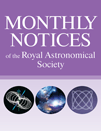A novel method to photometrically constrain orbital eccentricities: Multibody Asterodensity Profiling
ABSTRACT
We present a novel method to determine eccentricity constraints of extrasolar planets in systems with multiple transiting planets through photometry alone. Our method is highly model independent, making no assumptions about the stellar parameters and requiring no radial velocity, transit timing or occultation events. Our technique exploits the fact the light-curve-derived stellar density must be the same for all planets transiting a common star. Assuming a circular orbit, the derived stellar density departs from the true value by a predictable factor, Ψ, which contains information on the eccentricity of the system. By comparing multiple stellar densities, any differences must be due to eccentricity and thus meaningful constraints can be placed in the absence of any other information. The technique, called ‘Multibody Asterodensity Profiling’ (MAP), is a new observable which can be used alone or in combination with other observables, such as radial velocities and transit timing variations. An eccentricity prior can also be included as desired. MAP is most sensitive to the minimum pair-combined eccentricity e.g. (e1+e2)min. Individual eccentricity constraints are less stringent but an empirical eccentricity posterior is always derivable and is freely available from transit photometry alone.
We present a description of our technique using both analytic and numerical implementations, followed by two example analyses on synthetic photometry as a proof of principle. We point out that MAP has the potential to constrain the eccentricity, and thus habitability, of Earth-like planets in the absence of radial velocity data, which is likely for terrestrial-mass objects.




